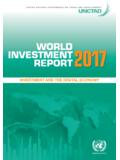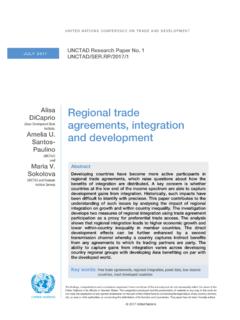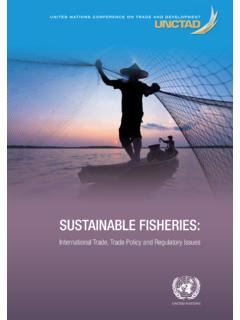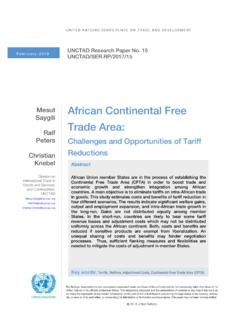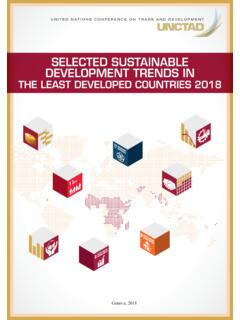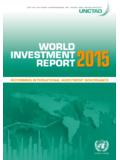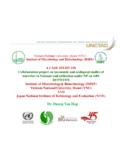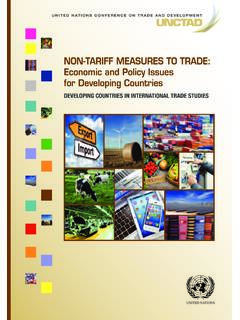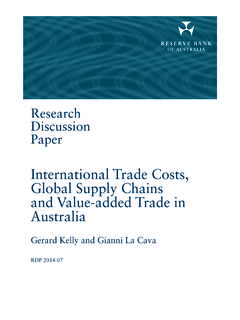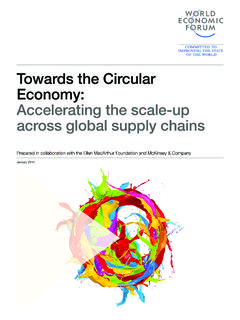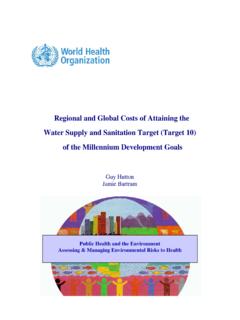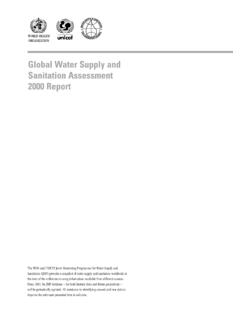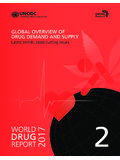Transcription of GLOBAL SUPPLY CHAINS: TRADE AND ECONOMIC …
1 U n i t e d N at i o n s C o n f e r e n c e o n T r a d e A n d D e v e l o p m e n t GLOBAL SUPPLY CHAINS: TRADE AND ECONOMIC POLICIES. FOR DEVELOPING COUNTRIES. POLICY ISSUES IN INTERNATIONAL TRADE AND COMMODITIES. STUDY SERIES No. 55. UNITED NATIONS CONFERENCE ON TRADE AND DEVELOPMENT. POLICY ISSUES IN INTERNATIONAL TRADE AND COMMODITIES. STUDY SERIES No. 55. GLOBAL SUPPLY CHAINS: TRADE AND ECONOMIC POLICIES. FOR DEVELOPING COUNTRIES. by Alessandro Nicita Victor Ognivtsev Miho Shirotori UNCTAD, Geneva UNITED NATIONS. New York and Geneva, 2013. Note The purpose of this series of studies is to analyse policy issues and to stimulate discussions in the area of international TRADE and development. The series includes studies by UNCTAD staff and by distinguished researchers from academia. This paper represents the personal views of the authors only, and not the views of the UNCTAD secretariat or its member States.
2 The designations employed and the presentation of the material do not imply the expression of any opinion on the part of the United Nations concerning the legal status of any country, territory, city or area, or of authorities or concerning the delimitation of its frontiers or boundaries. This publication has not been formally edited. Material in this publication may be freely quoted or reprinted, but acknowledgement is requested, together with a copy of the publication containing the quotation or reprint to be sent to the UNCTAD secretariat at the following address: Chief TRADE Analysis Branch Division on International TRADE in Goods and Services, and Commodities United Nations Conference on TRADE and Development Palais des Nations CH-1211 Geneva Series Editor: Victor Ognivtsev Officer-in-Charge, TRADE Analysis Branch UNCTAD/ITCD/TAB/56. UNITED NATIONS PUBLICATION. ISSN 1607-8291. Copyright United Nations 2013.
3 All rights reserved ii Abstract Over the last three decades, GLOBAL SUPPLY chains (GSCs) have increasingly gained importance in linking developing countries to international markets. Today a substantial share of the production processes of GSCs is taking place in developing countries. For developing countries and their enterprises, GSCs offer opportunities as well as challenges. While greatly facilitating access to developed countries' markets, GSCs also demand greater efficiency and competence from suppliers. For developing countries, it is thus important to implement ECONOMIC policies that while increasing the competitiveness of their enterprises, also improve their reliability and efficiency. In the past, the competitiveness of developing countries' enterprises was mainly based on TRADE policies, often in the form of preferential market access. TRADE policies, although still important, are no longer sufficient.
4 The reason is not only because of the preference erosion and decline of tariffs, but also because of the GSCs business model itself. In GSCs, competitiveness (and thus delocalization choices) is determined by a wide range of factors, especially by the quality of policies influencing the overall business environment. In this regard, LDCs and other low- income countries are often confronted with substantial disadvantages as implementing these policies require substantial resources that are lacking. In the absence of business supporting national policies, LDCs and low-income countries would continue to participate in GSCs only as providers of low value added components that have only a limited contribution to their development. Keywords: GLOBAL SUPPLY chains, TRADE policy, international TRADE , LDCs. JEL Classification: F1. iii Acknowledgements We would like to thank Bolormaa Tumurchudur for excellent research assistance.
5 We would like to express our sincere thanks to Marco Fugazza and Alberto Gabriele for comments at different stages of the preparation of the paper. Any mistakes or errors remain the authors' own. iv Contents I. Introduction ..1. II. Evolution of GSCs and developing countries ..4. III. GSCs: trends in international TRADE ..7. IV. GSCs: TRADE and ECONOMIC V. Rising along the value chain ..15. VI. Policy Bibliography ..20. v List of figures Figure 1. Value addition in a 6. Figure 2. Trends in international 7. Figure 3. China's TRADE in intermediate products within the East and South-East Asian region .. 9. Figure 4. Export sophistication .. 15. List of tables Table 1. World TRADE in intermediates .. 8. Table 2. Exports of intermediate products for developing/. transition country income groups and 8. Table 3. Distribution of world TRADE in intermediate products across regions (2008) .. 9. Table 4. Composition of intermediate exports across industries and regions (2008).
6 10. Table 5. Average effectively applied tariffs on selected industries (final and intermediate products).. 11. Table 6. TRADE policy and business environment, by income country 12. Table 7. Importance of traditional TRADE policy versus overall business environment .. 13. List of boxes Box 1. Buyer-supplier relational linkage strength of GLOBAL SUPPLY chains .. 3. Box 2. Services offshoring .. 5. Box 3. Bangladesh and Cambodia in GLOBAL SUPPLY chains in the garment sector .. 17. vi I. Introduction Over the last three decades, the progressive liberalization of cross-border transactions, advances in production technology and information services, and improvement in transport logistics and services have provided firms with greater incentives to fragment production processes and to geographically delocalize them. GLOBAL SUPPLY or production chains (GSCs), where cost reduction strategies result in goods often being produced with intermediate inputs originating from several countries, are now common in many industries and extend over to an increasing number of developing countries.
7 From an ECONOMIC standpoint, the emergence of GSCs is related to the concept of comparative advantage. By relocating production processes ( R&D, concept, design, manufacturing, packaging, marketing, distribution and retailing) in different countries, transnational corporations (TNCs) can take advantage of the best available human or physical resources in different countries, with a view to maintaining their competitiveness by augmenting productivity and minimizing For developing countries and their enterprises, the potential opportunities from joining GSCs are substantial. Indeed, integration into GSCs has become an important pillar of their policies for export-led development. GSCs enable producers within the chain to obtain modern management know-how and hands-on information on quality standards and technology, and thus to become more competitive. Such producers also quickly learn about demand patterns in high-income markets and consumer preferences in such Participation in GSCs could also create economy-wide externalities for developing countries, such as employment, improvement in technology and skills, productive capacity upgrading and export diversification into more value added.
8 In turn, those externalities would increase their attractiveness for more foreign direct investment. These potential gains explain the acute interest of policymakers in many developing countries over ways to link their private sectors to GSCs. However, GSCs are fundamentally a business strategy of TNCs, and are driven by their own business interests. Low labour costs alone are not a sufficient justification for relocating a part of TNCs' production processes. GSCs also rely on sophisticated and competitive networks of goods and information flow. Participating and upgrading along the chains require not only manufacturing skills but also a sound business environment that are often lacking in developing countries. GSCs have different structures depending on three main factors: (1) the geography and nature of linkages between tasks in the chain ; (2) the distribution of power among lead firms (TNCs) and other actors in the chain ; and (3) the role of government institutions and policies in structuring business relationships and industrial The first factor, the geographical structure, is determined by the extent of fragmentation of production processes and by their delocalization.
9 While the extent of fragmentation is generally specific to the sector, the choice of where to delocalize production processes depends not only on production and TRADE costs but also on the potential size of the domestic/regional market, as well as on the proximity to high-income markets. The extent to which local markets are integrated with regional/international markets both in regard to TRADE policies and infrastructure development is also important. 1. UNCTAD (2010a). 2. Gereffi (1999); Altenburg (2000); Tewari (1998). 3. Sturgeon and Gereffi (2009). 1. The second factor, the distribution of power among the various firms of GSCs, is reflected in the different organizational structures of GSCs. Their structures can be classified in terms of the relational linkage between the buyers (lead firm) and their suppliers of manufactures (box 1). One extreme is the case of vertical integration where some of the manufacturing stages are directly owned by the lead firm while certain parts and components may be bought from contract suppliers.
10 The other extreme is the case of a contractual relationship at arm's length, where buyers do not necessarily know and do not own their suppliers. Numerous types of ownership structures can be found anywhere within the wide spectrum of the buyer-supplier relationship. The third factor is related to government intervention. Governments play an important role in facilitating the integration of domestic firms into GSCs. Governments have often recurred to TRADE policies to increase the competitiveness of their enterprises, especially by seeking preferential market access. Indeed, by lowering TRADE costs TRADE policies can help to integrate domestic firms into GSCs. However, TRADE policies although still important are not sufficient in the GSCs business model. The removal of behind-the-border TRADE -related barriers is also Moreover, policies aimed at improving the overall business environment are essential to facilitating the integration of domestic firms into markets that are increasingly dominated by GSCs.

